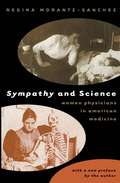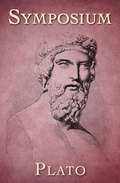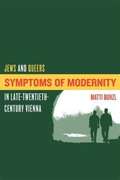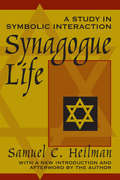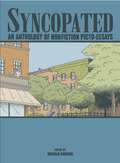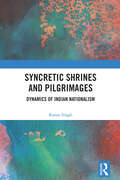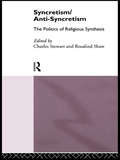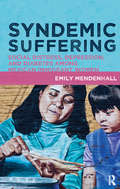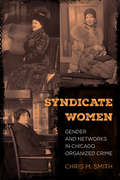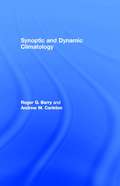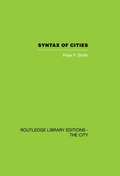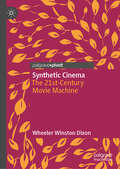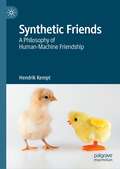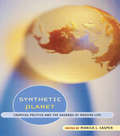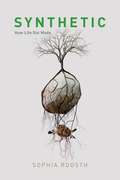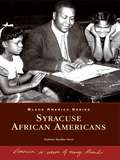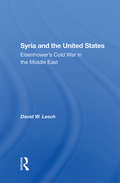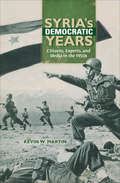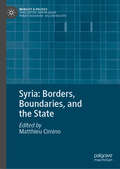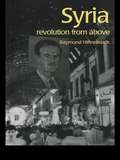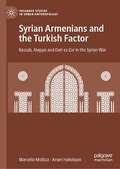- Table View
- List View
Sympathy and Science
by Regina Morantz-SanchezWhen first published in 1985, Sympathy and Science was hailed as a groundbreaking study of women in medicine. It remains the most comprehensive history of American women physicians available. Tracing the participation of women in the medical profession from the colonial period to the present, Regina Morantz-Sanchez examines women's roles as nurses, midwives, and practitioners of folk medicine in early America; recounts their successful struggles in the nineteenth century to enter medical schools and found their own institutions and organizations; and follows female physicians into the twentieth century, exploring their efforts to sustain significant and rewarding professional lives without sacrificing the other privileges and opportunities of womanhood. In a new preface, the author surveys recent scholarship and comments on the changing world of women in medicine over the past two decades. Despite extraordinary advances, she concludes, women physicians continue to grapple with many of the issues that troubled their predecessors.
Symposium: Annotated
by PlatoA fascinating discussion on sex, gender, and human instincts by one of history’s greatest philosophers. In the course of a lively drinking party, a group of Athenian intellectuals exchange views on desire. From their conversation emerges a series of subtle reflections on gender roles, sex in society, and basic human instincts. The debate precedes one great after another: Agathon, Aristodemus, Eryximachus, Pausanias, Aristophanes, and Socrates—all describing love in many possible permutations and combinations. The dialogue culminates in a radical challenge to conventional views by Plato’s mentor, Socrates, who advocates transcendence through spiritual love. The Symposium is a deft interweaving of different viewpoints and ideas about the nature of love.
Symptoms of Modernity: Jews and Queers in Late Twentieth-century Vienna
by Matti BunzlThis book is an ethnography of Central European modernity in the form of a comparative study of Jews and queers in late twentieth-century Vienna.
Synagogue Life: A Study in Symbolic Interaction
by Samuel C. HeilmanVia a participant-observer approach, Synagogue Life analyzes the three essential dimensions of synagogue life: the houses of prayer, study, and assembly. In each Heilman documents the rich detail of the synagogue experience while articulating the social and cultural drama inherent in them. He illustrates how people come to the synagogue not only for spiritual purposes but also to find out where and how they fit into life in the neighborhood in which they share.In his new introduction, Heilman discusses what led him to write this book and the process of personal transformation through which he, as an Orthodox Jew, had to go in order to turn a disciplined eye on the world from which he came. Rather than using the stranger-as-native approach of classic anthropology, he had instead to begin as a native who discoverd how to look at a once-taken-for-granted synagogue life like a stranger. In the afterword, arguing for the efficacy of this approach, Heilman offers guidance on how natives can use their special familiarity and still be trained to distance themselves from their own group, making use of the disciplines of sociology and anthropology. Synagogue Life offers a fascinating portrait that has something to say to social scientists as well as all those curious about what happens in the main arena of Orthodox Jewish community life.
Syncopated: An Anthology of Nonfiction Picto-Essays
by Brendan BurfordThe stories in Syncopated challenge convention, provide perspective, and search out secret truths–all in the inviting, accessible form of comics. Syncopated will give you a daringly different view of the past–from the history of vintage postcards to the glory days of old Coney Island. It will immerse you in fascinating subcultures, from the secret world of graffiti artists to the chess champs of Greenwich Village. And it will open your eyes to pieces of forgotten history–for example, the Tulsa race riots of 1921–and to new perspectives on critical current events, such as the interrogation of prisoners at Guantánamo Bay. These &“picto-essays&” encompass memoir, history, journalism, and biography in varied visual styles–each handpicked by Brendan Burford, one of America&’s top editors.Including:How and Why to Bale Hay by Nick Bertozzi Penny Sentiments by Rina Piccolo Boris Rose: Prisoner of Jazz by Brendan Burford and Jim Campbell Portfolio by Tricia Van den Bergh Father Figures by Josh Neufeld West Side Improvements by Alex Holden The Evening Hatch by Richard and Brian Haimes What We So Quietly Saw by Greg Cook &“Like Hell I Will&” by Nate Powell Welcome Home, Brave by Dave Kiersh The Sound of Jade by Sarah Glidden Subway Buskers by Victor Marchand Kerlow Erik Erikson by Paul Karasik Dvorak by Alec Longstreth A Coney Island Rumination by Paul Hoppe An Encounter with Richard Peterson by Brendan Burford
Syncretic Shrines and Pilgrimages: Dynamics of Indian Nationalism
by Karan SinghThis book looks at various syncretic traditions in India, such as Bhakti, Nath Yogi, Sufi, Imam Shahi, Ismailis, Khojas and others, and presents an elaborate picture of a redefined cultural space through them. It also investigates different syncretisms - Hindu-Muslim, Hindu-Muslim-Christian and Aboriginal-Ethnic - to understand diverse aspects of hybridity within the Indian nation space. It discusses how Indian nationalism was composed of different opinions from its inception, reflecting its rich diversity and pluralistic traditions. The book traces the emergence of multiple contours of Indian nationalism through the historical trajectory of religious diversity, lingering effects of colonialism, and experimentation with secularism. This volume caters to scholars and students interested in cultural studies, religion studies, pilgrimage studies, history, social anthropology, historical sociology, historical geography, religion and art history. It will also be of interest to political theorists and general readers.
Syncretism/Anti-Syncretism: The Politics of Religious Synthesis (European Association of Social Anthropologists)
by Charles Stewart Rosalind ShawSyncretism - the synthesis of different religious - is a contentious word. Some regard it as a pejorative term, referring to local versions of notionally standard `world religions' which are deemed `inauthentic' because saturated with indigenous content. Syncretic versions of Christianity do not conform to `official' (read `European') models. In other contexts however, the syncretic amalgamation of religions may be validated as a mode of resistance to colonial hegemony, a sign of cultural survival, or as a means of authorising political dominance in a multicultural state. In Syncretism/Anti-Syncretism the contributors explore the issues of agency and power which are integral to the very process of syncretism and to the competing discourses surrounding the term.
Syndemic Suffering: Social Distress, Depression, and Diabetes among Mexican Immigrant Wome (Advances in Critical Medical Anthropology #4)
by Emily MendenhallIn a major contribution to the study of diabetes, this book is the first to analyze the disease through a syndemic framework. An innovative, mixed-methods study, Emily Mendenhall shows how adverse social conditions, such as poverty and oppressive relationships, disproportionately stress certain populations and expose them to disease clusters. She goes beyond epidemiological research that has linked diabetes and depression, revealing how broad structural inequalities play out in the life histories of individuals, families, and communities, and lead to higher rates of mortality and morbidity. This intimate portrait of syndemic suffering is a model study of chronic disease disparity among the poor in high income countries and will be widely read in public health, medical anthropology, and related fields.
Syndicate Women: Gender and Networks in Chicago Organized Crime
by Chris M. SmithIn Syndicate Women, sociologist Chris M. Smith uncovers a unique historical puzzle: women composed a substantial part of Chicago organized crime in the early 1900s, but during Prohibition (1920–1933), when criminal opportunities increased and crime was most profitable, women were largely excluded. During the Prohibition era, the markets for organized crime became less territorial and less specialized, and criminal organizations were restructured to require relationships with crime bosses. These processes began with, and reproduced, gender inequality. The book places organized crime within a gender-based theoretical framework while assessing patterns of relationships that have implications for non-criminal and more general societal issues around gender. As a work of criminology that draws on both historical methods and contemporary social network analysis, Syndicate Women centers the women who have been erased from analyses of gender and crime and breathes new life into our understanding of the gender gap.
Synoptic and Dynamic Climatology
by Roger G. Barry Andrew M. CarletonSynoptic and Dynamic Climatology provides the first comprehensive account of the dynamical behaviour and mechanisms of the global climate system and its components, together with a modern survey of synoptic-scale weather systems in the tropics and extratropics, and of the methods and applications of synoptic climate classification. It is unrivalled in the scope and detail of its contents. The work is thoroughly up to date, with extensive bibliographies by chapter. It is illustrated with nearly 300 figures and plates.*Part 1 provides an introduction to the global climate system and the space-time scales of weather and climate processes, followed by a chapter on climate data and their analysis*Part 2 describes and explains the characteristics of the general circulation of the global atmosphere and includes the nature and causes of global teleconnection patterns*Part 3 discusses synoptic weather systems in the extratropics and tropics and satellite-based climatologies of synoptic features. It also describes the applications of synoptic climatology and summarises current climatic research and its directions.
Synthetic Cinema: The 21st-Century Movie Machine
by Wheeler Winston DixonIn this book, Wheeler Winston Dixon argues that 21st-century mainstream filmmaking is increasingly and troublingly dominated by "synthetic cinema." He details how movies over the last two decades have fundamentally abandoned traditional filmmaking values through the overwhelming use of computer generated imagery, digital touch ups for the actors, and extensive use of green screen technology that replace sets and location shooting. Combined with the shift to digital cinematography, as well as the rise of comic book and franchise cinema, the temptation to augment movies with lavish, computer generated spectacle has proven irresistible to both directors and audiences, to the point that, Dixon argues, 21st-century commercial cinema is so far removed from the real world that it has created a new era of flawless, fake movies.
Synthetic Friends: A Philosophy of Human-Machine Friendship
by Hendrik KemptThis book explores the notion of whether we can be friends with machines in a philosophically meaningful way. Depending on our concept of friendship, we may be inclined to answer differently. Since social technology has made new forms of friendships possible between people across the globe, the author argues that the philosophical concept of friendship, forged thousands of years ago, should be re-examined. The author proposes a new approach to the debate that reflects the unique relationship we can build with machines as our synthetic friends.
Synthetic Planet: Chemical Politics and the Hazards of Modern Life
by Monica J. CasperThis timely collection of original essays traces the migration of synthetic chemicals from the laboratory to the factory and then into the environment, bodies and communities. Turning our attention to the impact these chemicals have on our ecosystems, human health, social organization and political processes, the contributors break new ground by focusing on the production and distribution of these potentially hazardous agents themselves rather than just detailing their effects.
Synthetic: How Life Got Made
by Sophia RoosthIn the final years of the twentieth century, émigrés from engineering and computer science devoted themselves to biology and resolved that if the aim of biology is to understand life, then making life would yield better theories than experimentation. Armed with the latest biotechnology techniques, these scientists treated biological media as elements for design and manufacture: viruses named for computers, bacterial genomes encoding passages from James Joyce, chimeric yeast buckling under the metabolic strain of genes harvested from wormwood, petunias, and microbes from Icelandic thermal pools. In Synthetic: How Life Got Made, cultural anthropologist Sophia Roosth reveals how synthetic biologists make new living things in order to understand better how life works. The first book-length ethnographic study of this discipline, Synthetic documents the social, cultural, rhetorical, economic, and imaginative transformations biology has undergone in the post-genomic age. Roosth traces this new science from its origins at MIT to start-ups, laboratories, conferences, and hackers’ garages across the United States—even to contemporary efforts to resurrect extinct species. Her careful research reveals that rather than opening up a limitless new field, these biologists’ own experimental tactics circularly determine the biological features, theories, and limits they fasten upon. Exploring the life sciences emblematic of our time, Synthetic tells the origin story of the astonishing claim that biological making fosters biological knowing.
Syracuse African Americans (Black America Series)
by Barbara Sheklin DavisSyracuse African Americans abounds with hard work, forbearance, determination, strength, and spirit. It depicts through photographs the heritage of this upstate New York African American community. The story spans several centuries, beginning when escaped slaves made salt here and sold it to the Native Americans. Once a hotbed of abolitionism, Syracuse was the site of a protest against the Fugitive Slave Law. Later, as the city became a manufacturing center, its black population increased.
Syria 1945-1986: Politics and Society (Routledge Library Editions: Syria)
by Derek HopwoodSyria has often lacked sympathetic observers. This book tries to interpret the country and its people in terms of how they see their own history and of what they are trying to achieve. More than a political or diplomatic history, it discusses the economy, society, education and culture to help the reader understand and explain modern Syria. A description of the country deals with the physical and other factors which have influenced Syria’s development. An historical survey concentrates mainly on the period after the Second World War and explains why a knowledge of Syrian history is important and why Syrians look at their history in the way they do. The achievements, problems and failures of President Asad are fully discussed. Further chapters explain the ideological factors which have been of vital importance in Syrian politics, the development of education, the economy and society. The author looks at examples of contemporary Syrian literature and the way in which writers view the problems of their society and culture. This is a clear, succinct and readable account of modern Syria which will be essential for all those studying the Middle East, the developing world or international relations.
Syria And The United States: Eisenhower's Cold War In The Middle East
by David W. LeschThe "Syrian crisis" of 1957, sparked by a covert attempt by the Eisenhower administration to overthrow what it perceived to be an emerging Soviet client state in the Middle East, represented the denouement of a badly misguided U.S. foreign policy, according to David Lesch. The repercussions of this incident, which almost precipitated a superpower c
Syria Under Assad: Domestic Constraints and Regional Risks (Routledge Library Editions: Syria)
by Moshe Maoz Avner YanivOne of the most striking recent developments in the modern Middle East has been the transformation of Syria under Hafez al-Assad from a weak, vulnerable and internally divided state to a leading regional power. While this is increasingly acknowledged by observers of the Middle Eastern scene , the scholarly discussion of the origins, the scope, the durability and the implications of this change is only beginning to take place. Syria Under Assad addresses itself to this discussion. Based on a carefully selected collection of original articles, this volume focuses on the elements of Syria’s power, on Syria’s relations with each of its neighbours as well as on Syria’s relations with the superpowers. In the final analysis, conclude the editors, Syrian policies appear paradoxical. Its conduct ever since the advent of Hafez al-Assad exhibits subtle and hard-nosed pragmatism. Yet, in order to consolidate the domestic legitimacy of the Alawi Ba’athist regime, Syria has been impelled to articulate its foreign policy goals in the far-flung rhetoric of the Ba’athist ideology. As a result Syria is widely perceived of as a menace and, treated as such, it often responds in kind.
Syria in World War I: Politics, economy, and society (SOAS/Routledge Studies on the Middle East)
by M. Talha ÇiçekThe First World War quickly escalated from a European war into a global conflict that would cause fundamental changes in the Middle East, Africa, Asia and the Americas. Its end signalled the dissolution of the Ottoman Empire, which had controlled most of the Arab Middle East. Over the wartime period, millions of people across the Empire died as a result of warfare, epidemics, famines and massacres. However, for the Ottoman leaders their entry into the war was not just a response to a life-or-death struggle, but rather presented them with an opportunity to transform the empire into a new type of state. Syria in World War I brings together leading scholars working with original Turkish, Arabic, Armenian and German sources, to present a comprehensive examination of this key period in Syria’s history. Together, the chapters demonstrate how the war represented a radical break from the past for the Syrian lands, which underwent crucial political, economic, social and cultural transformations. It contextualises various facets of the then Unionist ruler of Syria, Djemal Pasha, as well as exploring the impact of the Ottoman leaders’ divergent policies on the Syrian lands and people, which would undergo a series of political, economic and ecological catastrophes whose traces are still evident in the region’s collective memory. Introducing a significant body of new information and considerably expanding the parameters of current debates, Syria in World War I is of key interest to students and scholars of Middle East History, as well as History of the Late Ottoman Empire and World War I History.
Syria's Democratic Years: Citizens, Experts, and Media in the 1950s (Encounters: Explorations in Folklore and Ethnomusicology)
by Kevin W. MartinThis study of mid-20th century Syria blends &“cultural theory and comparative history&” to offer &“intellectual depth and relevance beyond the case at hand&” (The Middle East Journal). When Syria became fully independent in 1946, the young republic faced the task of forging a new national identity. From 1954 to 1958, Syria enjoyed a brief period of civilian government—popularly known as &“The Democratic Years&”—before the consolidation of authoritarian rule. In Syria&’s Democratic Years, Kevin W. Martin provides a cultural history of the period and argues that the authoritarian outcome was anything but inevitable. Examining the flourishing broadcast and print media of the time, Martin focuses on three public figures, whose professions—law, the military, and medicine—projected modernity and modeled the new Arab citizen. This experiment with democracy, however abortive, offers a model of governance from Syria&’s historical experience that could serve as an alternative to dictatorship.
Syria's Kurds: History, Politics and Society (Routledge Advances in Middle East and Islamic Studies #16)
by Jordi TejelThis book is a decisive contribution to the study of Kurdish history in Syria since the mandatory period (1920-1946) up to nowadays. Avoiding an essentialist approach, Jordi Tejel provides fine, complex and sometimes paradoxical analysis about the articulation between tribal, local, regional, and national identities, on one hand, and the formation of a Kurdish minority awareness vis-à-vis the consolidation of Arab nationalism in Syria, on the other hand. Using unpublished material, in particular concerning the Mandatory period (French records and Kurdish newspapers) and social movement theory, Tejel analyses the reasons of this "exception" within the Kurdish political sphere. In spite of the exclusion of Kurdishness from the public sphere, especially since 1963, Kurds of Syria have avoided a direct confrontation with the central power, most Kurds opting for a strategy of "dissimulation", cultivating internally the forms of identity that challenge the official ideology. The book explores the dynamics leading to the consolidation of Kurdish minority awareness in contemporary Syria; an ongoing process that could take the form of radicalization or even violence.
Syria: Borders, Boundaries, and the State (Mobility & Politics)
by Matthieu CiminoThis book explores the history of Syria’s borders and boundaries, from their creation (1920) until the civil war (2011) and their contestation by the Islamic State or the Kurdish movement. The volume’s main objective is to reconsider the “artificial” character of the Syrian territory and to reveal the processes by which its borders were shaped and eventually internalized by the country’s main actors. Based on extensive archival research, the book first documents the creation and stabilization of Syrian borders before and during the mandates period (nineteenth century to 1946), studying Ottoman and French territorialization strategies but also emphasizing the key role of the borderlands in this process. In turn, it investigates the perceptual boundaries resulting from the conflict, and how they materialized in space. Lastly, it explores the geographical and political imaginaries of non-state actors (PYD, ISIS) that emerged from the war.
Syria: Revolution From Above (The Contemporary Middle East)
by Raymond HinnebuschThis study examines the development of the Syrian state as it has emerged under thirty-five years of military-Ba'thist rule and, particularly, under President Hafiz al-Asad. It analyzes the way in which the fragility of the post-independence state, unable to contain rising nationalist struggle and class conflict, opened the way to the Ba'th party's rise to power and examines how the Ba'th's 'revolution from above' transformed Syria's socio-political terrain.
Syrian Armenians and the Turkish Factor: Kessab, Aleppo and Deir ez-Zor in the Syrian War (Palgrave Studies in Urban Anthropology)
by Marcello Mollica Arsen HakobyanThis volume examines significant social transformations engendered by the ongoing Syrian conflict in the lives of Syrian Armenians. The authors draw on documentary material and fieldwork carried out in 2013-2019 among Syrian Armenians in Armenian and Lebanese urban settings. The stories of Syrian Armenians reveal how contemporary events are seen to have direct links to the past and to reproduce memories associated with the Armenian genocide; the contemporary involvement of Turkey in the Syrian war, for example, is seen on the ground as an attempt to control the Armenian presence in Syria. Today, the Syrian Armenian identity encapsulates the complex intersection of memory, transnational links to the past, collective identity and lived experience of wartime “everydayness.” Specifically, the analysis addresses the role of memory in key events, such as the bombing of Armenian historical sites during the commemorations of 24 April in the Eastern Syrian city of Deir ez-Zor; the (perceived) shift from destroying Syrian Armenians’ material culture to attempting to destroy the Armenian community in urban Aleppo; and the informal transactions that take place in the border area of Kessab. This carefully-researched ethnography will appeal to scholars of anthropology, sociology, and political science who specialize in studies of conflict, memory and diaspora.
